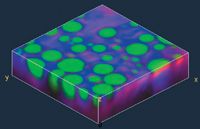Highest Spectral and Spatial Resolution for Chemical Imaging
Raman microscopy is a high resolution imaging technique that has become widely used for the characterization of materials in terms of their chemical composition.
Raman microscopy is a high resolution imaging technique that has become widely used for the characterization of materials in terms of their chemical composition. Through the selection of optimized microscope components it is possible to approach the theoretical limit in spectral and spatial resolution. In this way information on sample properties can be obtained on the micro- and even nano-scale.
Confocal Raman Microscopes
Confocal Raman microscopy combines chemical sample characterization with the imaging capabilities of an optical microscope. Thereby, a spatial resolution down to 200 nm can be achieved. In a confocal microscope, only light from the focal plane is detected while out of focus light is rejected, thus providing depth resolution and a strongly reduced background signal. Images are recorded point by point and line by line while scanning the sample through the excitation focus. With this technique, the specimen can be analyzed in steps along the optical axis and even a depth profile or 3D image can be generated.
The Resolution
The spectral and spatial microscope resolutions are important factors for the quality of the acquired measurements. The spectral resolution of a confocal Raman microscope is mainly defined by the individual components of the spectroscopic system. The focal lengths, the grating, the pinhole, the pixel size of the CCD camera, and the imaging quality of the spectrometer all contribute to optimization.
In case of the spatial resolution of a confocal Raman microscope the lateral (x- and y-direction) and the depth resolution (z-direction) can be distinguished. Besides the fundamental laws of physics (such as the diffraction limit), the spatial resolution is defined by the mechanical and optical microscope components which can influence the sample position accuracy, aberration, and beam path distortion. In Figure 1 the experimental determination of the lateral resolution of a confocal Raman microscope is shown. The measurable lateral dimensions of a carbon nanotube sample can be determined via the full width at half maximum (FWHM) and the lateral resolution can be characterized at about 272 nm.

Figure 1: a) Integrated intensity of the G-Band of a carbon nanotube with the cross section position marked in red and the cross-sectional intensity along this line in (b). The lateral resolution of the microscope system can be characterized by the FWHM and is about 272 nm.
Furthermore, the depth resolution is an important characteristic of a confocal system. The instrument design and also the pinhole and the sample illumination influence the depth resolution. With the usage of proper microscope components a depth resolution below 750 nm can be achieved.
High Resolution and Ultrafast 3D Image Acquisition
In the following example, the high-resolution properties combined with the ultrafast confocal Raman imaging capabilities of the WITec alpha300 Raman microscope were used to analyze an oil-alkane-water emulsion three dimensionally. In a volume of 30 × 30 × 11.5 μm3, 23 confocal Raman scans were acquired in the z-direction leading to 23 Raman images each consisting of 150 × 150 pixels (22,500 spectra). The total acquisition time for one image was 60 s resulting in 23 min for the acquisition of the complete stack (517,000 Raman spectra). Using 3D-reconstruction software, a three dimensional image of the distribution of the three compounds can be generated as shown in Figure 2.

Figure 2: Three-dimensional reconstruction image of oil, alkane, and water distribution (green: oil, red: alkane, blue: water, 30 à 30 à 11.5 μm3, 150 à 150 à 23 pixels, 517,500 Raman spectra).
Conclusion
The spectral and spatial resolution of a confocal Raman microscope setup can be optimized by the usage of optimized optical and mechanical microscope components. In this way high-resolution depth scans and 3D Raman images can be generated and information about the chemical sample composition can be obtained.

WITec GmbH
Lise-Meitner-Str. 6, 89081, Ulm, Germany
tel. +49 (0) 731 140 700, fax: +49 (0) 731 140 70 200
Website: www.witec.de

Thermo Fisher Scientists Highlight the Latest Advances in Process Monitoring with Raman Spectroscopy
April 1st 2025In this exclusive Spectroscopy interview, John Richmond and Tom Dearing of Thermo Fisher Scientific discuss the company’s Raman technology and the latest trends for process monitoring across various applications.
A Seamless Trace Elemental Analysis Prescription for Quality Pharmaceuticals
March 31st 2025Quality assurance and quality control (QA/QC) are essential in pharmaceutical manufacturing to ensure compliance with standards like United States Pharmacopoeia <232> and ICH Q3D, as well as FDA regulations. Reliable and user-friendly testing solutions help QA/QC labs deliver precise trace elemental analyses while meeting throughput demands and data security requirements.